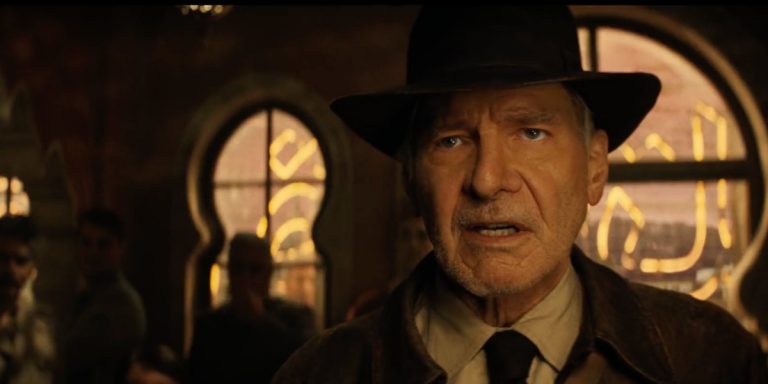David Fincher’s iconic 1999 psychological thriller Fight Club is one of the most celebrated films of the past quarter-century. Based on Chuck Palahniuk’s 1996 novel of the same name, it tells the story of the unnamed narrator (Edward Norton), unhappy and unfulfilled in his white-collar career as an automobile recall specialist, who forms a “fight club” with a soap salesman named Tyler Durden (Brad Pitt) and becomes intimately involved with a beautiful but frivolous thrill-seeking woman named Marla Singer (Helena Bonham Carter). The film garnered a cult following since its release.
Towards the end, in one of the most extraordinary twists in narrative cinema, we learn that Durden is nothing more than the imaginary alter-ego of the narrator, and every wild, disruptive act he carries out is the narrator fulfilling his fantasies. It epitomized the movie’s admirable ambition. Although it was widely critically acclaimed, Fight Club received just one Academy Award nomination for Best Sound Effects Editing, but it lost to The Matrix. As much as Fight Club’s success rested on the foundation of Ren Klyce and Richard Hymns’ tremendous sound design, The Matrix was a deserving winner for its suspenseful and immersive use of sound.
However, that Fight Club didn’t receive any other nominations and that it won none has been a point of contention among movie fans for many years. But could it be the most tragically overlooked Oscar loser ever? There’s certainly a strong argument for that being the case. There have been many theories about the reasons for Fight Club’s lack of Academy Award recognition, mainly that psychological thrillers don’t do well at the Oscars. However, that notion is disproven by the fact that 1991’s The Silence of the Lambs swept up at the awards, becoming only the third movie in history to win the coveted “Big Five” (Best Picture, Best Director, Best Actor, Best Actress, and Best Screenplay (either Best Original Screenplay or Best Adapted Screenplay).
There’s also the fact that Fight Club was highly controversial, with some critics calling the film “irresponsible” and even using words like “appalling” to describe it, suggesting it would cause violent copycat behavior in the same way A Clockwork Orange had almost three decades earlier in 1971. Alexander Walker of the London Evening Standard went as far as calling Fight Club a “Nazi piece of work” and a “paradigm of the Hitler state,” which could explain the Academy’s hesitancy to reward it. That said, the audience isn’t supposed to agree with what’s happening in the movie; its main character is a psychopath, and that’s its point, so anyone indulging in violent behavior because of it missed that entirely – and maybe the Academy did, too.
But the truth is none of that should take away from the fact it’s a spectacular piece of art anyway. The above-mentioned A Clockwork Orange received four nominations, including Best Picture, albeit without winning, and 1973’s The Exorcist – one of the most controversial films ever made – received an incredible ten nominations, also including Best Picture, and won two for Best Adapted Screenplay and Best Sound. Good films deserve recognition, controversial or not.
Having been nominated for Best Sound Effects Editing, it seems almost negligent for the Academy to have excluded Fight Club from the Best Sound category. Both of its fellow nominees in the Best Sound Effects Editing category – The Matrix and Star Wars: Episode I – The Phantom Menace – received nominations, with The Matrix again winning, so its omission is perplexing. Fight Club’s sound was intricately designed, with Kylce and Hymns hitting raw chicken carcasses filled with walnuts and, indeed, punching themselves in the chest, making the punches in the film sound particularly beefy, which married well with the music and overall design of the movie.
Fight Club was undoubtedly the most glaring omission from the 2000 ceremony’s Best Adapted Screenplay category. Palahniuk’s novel was well-received and praised for its creepy atmosphere, deadpan humor, satire, and sheer risk-taking – and the film’s writing encapsulates all of that perfectly. It had some intense competition – with the likes of The Talented Mr. Ripley, The Insider, The Green Mile, and Election among them – and while there are equally deserving winners in that list, it’s arguable Fight Club is as well-written as the movie that won, which was the somewhat anticlimactic The Cider House Rules.
While it’s probably fair that the brilliant, funny, and intelligent American Beauty won the Best Picture Academy Award in 2000, it’s also fair to say Fight Club is as good a film as several of Sam Mendes’ black comedy-drama’s fellow nominees. It’s visceral, thrilling, hard-edged, and superbly performed, and undoubtedly on par with the quality of The Green Mile and The Cider House Rules. Fincher’s direction on Fight Club was impeccable. The film is built with his aesthetic signature of high contrast lighting, a cold color tint, and underexposure, giving it a murky, grimy, and almost festering appearance.

Fincher is said to have shot an outrageous number of takes for each scene in his quest for perfection, exerting an infuriating control over his stars to mold their performances. The movie showcases him as a master of the craft, and his jurisdiction is evident throughout. With Lasse Hallström nominated for The Cider House Rules, which ultimately didn’t go anywhere, it’s clear that Fincher warranted a place among the nominees for Best Director, given he intricately guided Fight Club to a spectacular crescendo.
That Fight Club’s three main stars didn’t receive a single acting nomination between them is nothing short of shameful. Brad Pitt and Edward Norton are both Oscar-caliber actors, with the former receiving four nominations and winning one (for Once Upon a Time in Hollywood) and the latter winning none of his three nominations. Fight Club is arguably the career-best performance of both men. Norton is exceptional at portraying characters with dual natures, and he flawlessly conveys the hidden complexities of the narrator in the film. Pitt commands every scene as Tyler Durden with animated body language and expertly shifts his tone to match the movie’s constant alterations in perspective. They should both have been considered for the Best Actor award, given their performances were undeniably as great as Denzel Washington’s in The Hurricane and Sean Penn’s in Sweet and Lowdown.
Helena Bonham Carter’s Fight Club credentials for Best Supporting Actress are less convincing but still debateworthy. While she is an Oscar-caliber actress with two nominations, the competition was incredible in 2000. Her character, Marla Singer, is a bit dull and understated but still an essential aspect of the film, embodying the disruption and chaotic nature of the narrator’s life, his growing dissatisfaction and disappointment with modern society, and his struggles with identity and purpose. She may, therefore, have deserved a nod. Still, the role isn’t as emotionally demanding as Toni Collette’s in The Sixth Sense, Chloë Sevigny’s in Boys Don’t Cry, Samantha Morton’s in Sweet and Lowdown, Catherine Keener’s in Being John Malkovich, or Angelina Jolie’s winning performance in Girl, Interrupted. Therefore, her omission, while debatable, is probably fair enough.
Fight Club’s score was undoubtedly worthy of a Best Original Score nomination – it’s one of the best of the 1990s. Fincher had initially wanted Radiohead to write it. However, the band’s lead singer, Thom Yorke, turned down the opportunity, saying they were recuperating after the promotion of their 1997 album OK Computer, which induced a lot of stress. Instead, the director commissioned the breakbeat-producing duo Dust Brothers. Their nontraditional score broke new ground with computerized samples, electronic record scratches, and many drum loops, superbly capturing the film’s edgy, underground tone. Even John Corigliano’s romantic score for The Red Violin, which won the Oscar, couldn’t touch Fight Club’s for sheer atmospheric perfection.
It’s also baffling that the film didn’t get a Best Editing nomination. Fight Club’s editing is crisp, sharp, and slick and certainly helps to realize the world of Palahniuk’s novel. There are fast, jerky camera movements and many jumpcuts, making for a confusing visual experience that mirrors the lead character’s grasp on reality. The Matrix was a deserving winner in this category, but Fight Club had as much right to be in contention as The Cider House Rules, The Insider, and The Sixth Sense, each of which arguably didn’t benefit from great editing as much.
That brings us nicely to the Oscar for Best Cinematography. Fight Club missing out on a nomination in this category is tragic. Jeff Cronenweth’s work on the film is nothing short of sensational. Cronenweth desaturated the color palette, brilliantly highlighting the movie’s somber themes. His exceptional lighting adds texture and depth to every scene, and low-angle shots and extreme close-ups generate unease and disorientation, reminiscent of the lead character’s mental state. It’s as good as all the nominees for Best Cinematography, including The End of the Affair, Sleepy Hollow, Snow Falling on Cedars, and the winner American Beauty.
With all that in mind, Fight Club’s single nomination and zero wins at the 2000 Academy Awards seems ludicrous. One or two omissions from categories for which it realistically deserved nominations is understandable, but this many borders on silly and means it may legitimately be the most tragically overlooked film in the awards’ history.





![Oslo, August 31st [2011] Review – A Deeply Sympathetic Character Study of a Former Drug Addict](https://79468c92.delivery.rocketcdn.me/wp-content/uploads/2020/11/oslo-august-31st-768x432.jpg)

![An Angel at My Table [1990] – A Fitting Tribute to a Great Artistic Soul](https://79468c92.delivery.rocketcdn.me/wp-content/uploads/2017/03/An-Angel-at-my-Table-cover-768x429.jpg)